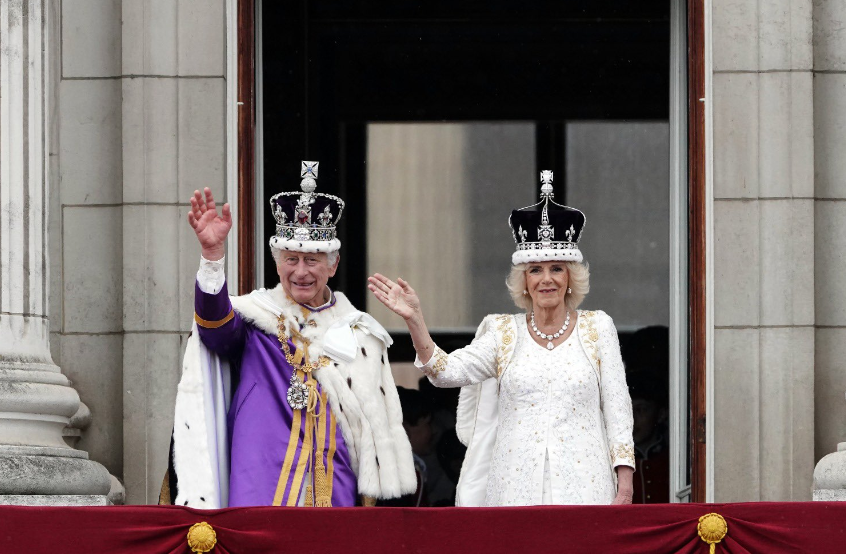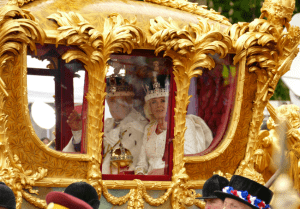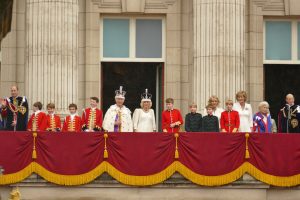
King Charles' coronation tweaks tradition, heralds modern era in British royal family

Not a single footstep or a horse’s hoof was misplaced during the spectacular Coronation ceremony that finally crowned King Charles III, the oldest monarch to ascend the throne of the United Kingdom. Whether it was the medieval pageantry, the religious service or the military parade, the coronation of the new king and queen went off without a hitch, impressive in its sheer scale, execution and splendour.
The only sour note was the weather with the grey skies and a slow drizzle throughout the day – but then again rain in these islands is as British as the monarchy itself. The rain did not dampen the spirits of the thousands who lined the 2.2 km route to cheer their new monarch as he rode to Buckingham Palace from Westminster Abbey in a gold state coach that sparkled even under the clouds.

It had also rained 70 years ago when Britain last witnessed a coronation, that of the young Elizabeth, Charles’s ‘dear Mama’, who was crowned queen at the tender age of 25. Charles was then a mere four-year-old and too young to realise as he sat with his grandmother in the Abbey that he too would go through the solemn rituals sometime in the future. However Charles’s nine-year-old grandson Prince George, who performed the role of one of the King’s four pageboys perfectly, is probably old enough to understand that as the second in line to the throne, he will be following in his grandfather’s footsteps one day.
Also read: King Charles III crowned King of United Kingdom at Westminster Abbey
The traditional Protestant service with the Christian hymns, prayers and the Eucharist performed by the Archbishop of Canterbury, the senior most Anglican priest, is steeped 500-year-old history dating back to when King Henry VIII broke away from the Vatican and formed the Church of England, becoming the chosen representative of God to rule over his people. Charles’s oath to serve and protect the Protestant faith, his private anointment behind beautifully embroidered screens from which he emerged in a plain white shirt to kneel before the altar and be blessed by the King of Kings, Jesus Christ, all followed religious rituals going back a thousand years.
A secular touch
However there were many innovations too in the service that brought modernity and inclusivity that had not been witnessed before. Helping the Archbishop of Canterbury, there were two female bishops – a historical first as the Church of England did not ordain female bishops until 2015. The hymns sung during the service for the first time included the joyful sound of gospel music sung by an all-black choir dressed in white.
The coronation procession into the Abbey was led by representatives of the Jewish, Sunni and Shiite Muslim, Hindu, Sikh, Buddhist, Jain, Bahai and Zoroastrian communities. At the end of the Christian service, these same community representatives delivered a spoken greeting in unison to the newly crowned King and Queen as they left the Abbey.
Also read: Five bizarre traditions around King Charles III’s crowning ceremony
Among the peers of the realm who handed objects of the royal regalia to the newly anointed King were members of the House of Lords belonging to the Hindu, Muslim, Sikh and Jewish faith. Lord Syed Kamall, a Muslim of Indo-Guyanese heritage handed Charles the Armills (bracelets) which represent sincerity and wisdom; Baroness Gillian Merron, a Jew, carried the Robe Royal, adorned with the symbols of the United Kingdom to the King; Lord Narendra Babubhai Patel, a Hindu presented the Sovereign’s Ring and the 90-year-old Sikh peer Lord Indrajit Singh gave the Coronation glove to Charles.
All new inclusions were added thanks to Charles who has had a lifelong fascination with other religions. While the King vowed to serve as “Defender of the Faith” i.e. Protestantism, the service was tweaked so that he also pledged “to seek to foster an environment in which people of all faiths and beliefs may live freely”.
Commonwealth takes the lead
Queen Elizabeth II’s coronation took place in 1953, in a very different Britain than the one of today. The grainy black and white visuals which were beamed into people’s homes for the first time through television sets show a homogenous white audience both in Westminster Abbey and on the streets. In the last 70 years the UK has become a multi-ethnic, multi-faith and multi-cultural society. Many of the 2,200 guests gathered inside the Abbey to watch the crowning were from ethnic minorities. From celebrities to sportspersons, members of the House of Lords and of the House of Commons – there were brown and black faces everywhere.
Also read: King Charles III: A monarch with a multi-faith outlook, great love for India
Among the positions of political power, Britain’s Indian-origin Prime Minister Rishi Sunak along with his Indian heiress wife Akhshata Murthy were prominent in the proceedings. Pakistani-origin First Minister Hamza Yousef came wearing a kilt to represent the devolved government of Scotland. Mayor of London Sadiq Khan, of Pakistani-origin and the Mayor of Westminster Hamza Taouzzale, of Moroccan heritage were both in attendance.
The late Queen had founded the British Commonwealth of nations and was a staunch supporter of it throughout her reign. King Charles honoured his mother by including heads of Commonwealth countries in the coronation procession into the Abbey. Vice-President Jagdeep Dhankhar and his wife Dr Sudesh Dhankhar represented India. Among the 4,000-strong military personnel that marched through the streets of London in front of the gold coach carrying the King and Queen were 447 officers drawn from troops of Commonwealth countries.
During his troubled first marriage with Lady Diana Spencer and their tempestuous divorce, questions had often been raised as to whether Charles would ever be allowed to become King, particularly after Diana was killed in a horrific road accident in 1997. After Charles married Camilla in 2005, there was speculation that Queen Elizabeth may break with tradition, skip a generation and pass the throne to Charles’s eldest son Prince William. Instead, the late Queen in her Platinum Jubilee speech last year announced that she would like Charles to be King and Camilla to be Queen as a reward for being a steadfast spouse to her beloved son.
Also read: Bengal woman designs dress for Queen Camilla, brooch for King Charles III
Recently, the royal family has been beset with fresh controversies and scandals – Prince Harry’s stepping down from royal duties after his marriage to Megan Markle and moving to live in the United States and Andrew, Duke of York being stripped of his position due to his friendship with convicted sex offender Jeffrey Epstein. Charles couldn’t not invite his younger son or his younger brother to the coronation, but both Harry and Andrew were relegated almost out of sight in the third row in the Abbey.
Select royals only
As the younger son of the King, Harry would have had pride of place next to his elder brother William had he not ruined relations with his family by giving a bare all interview to Oprah or written his controversial memoir Spare. Harry used his son Archie’s birthday as the excuse to fly back to the US immediately after the Westminster Abbey ceremony ended and avoid being in historic family photographs back at the Palace.
Unlike in the past when the balcony of Buckingham Palace would be filled with children, grandchildren, cousins and their families after such state events, King Charles and Queen Camilla invited only a select number of a trimmed down working royals firm. This way they were able to avoid controversies about whether Harry or Andrew should be there along with the other members of the royal family.

Watch | Ancient precious regalia used in Coronation of King Charles III
Becoming King at the age of 74, it is unlikely that Charles’s reign will be as long as his mothers, but he is determined to put his stamp on the monarchy. He has begun as he means to go on and by modernising the role of the royal family he would like to leave a legacy for future generations.


